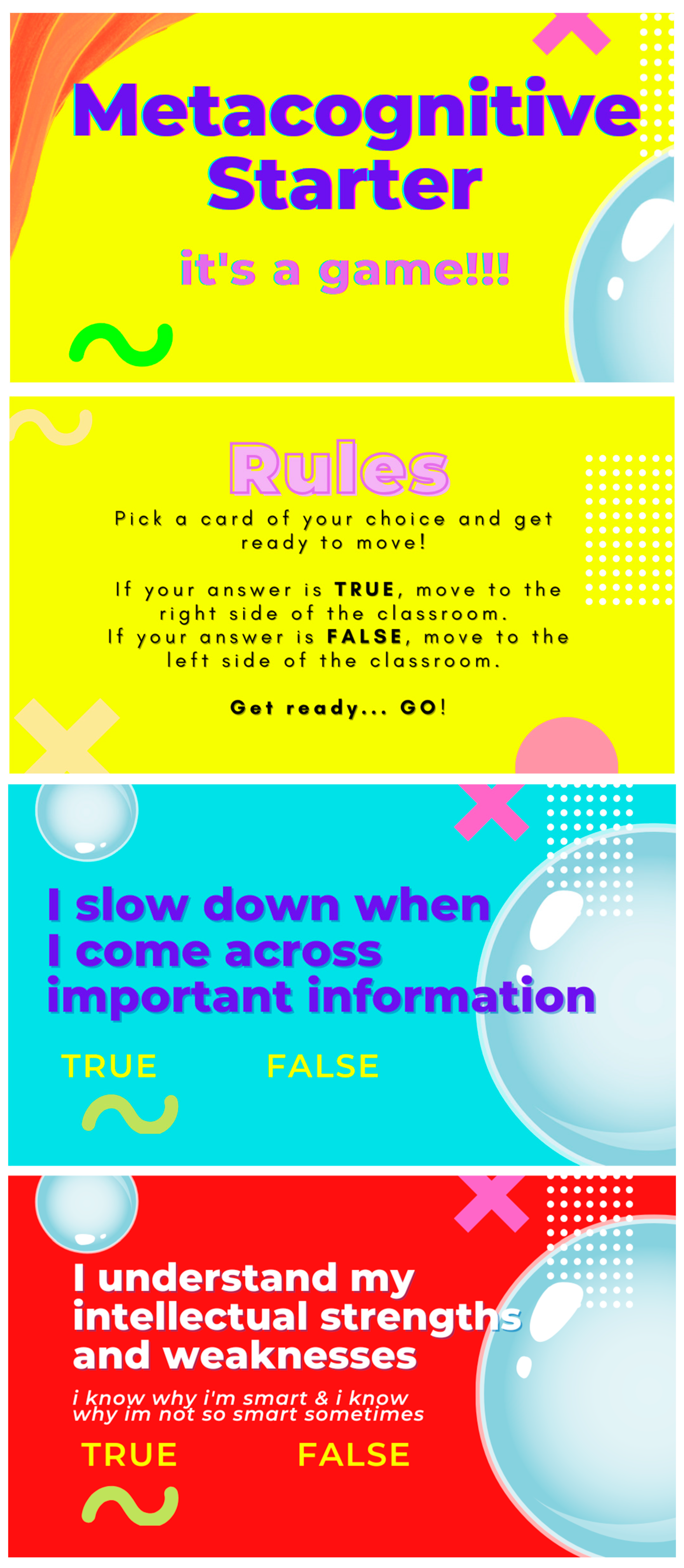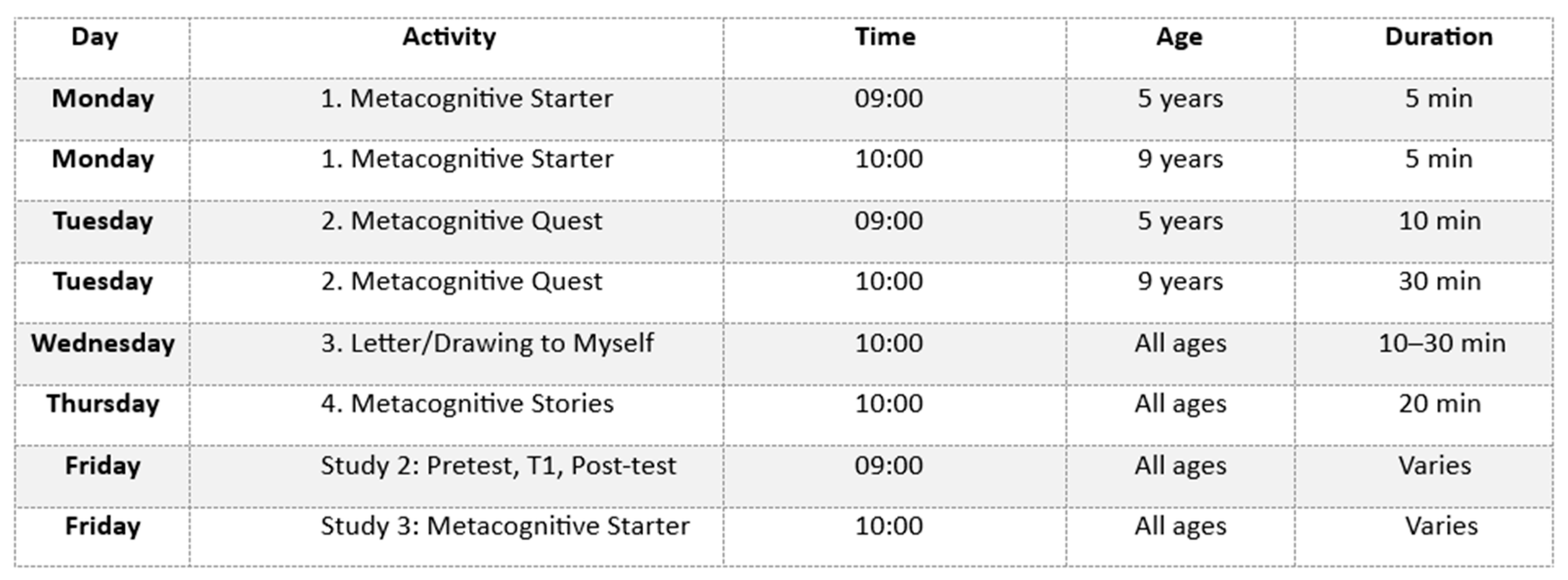1. Introduction
Metacognition is widely recognized as a core dimension of self-regulated learning, integrating knowledge, monitoring, and control processes applied to one’s own cognitive activity. Although it is often introduced through the heuristic phrase “thinking about thinking” (
Flavell 1979), such reduction obstructs the theoretical complexity, as well as the operational span of the construct.
In relation to intelligence, metacognition serves as a moderator by shaping how individuals apply their cognitive resources in tasks requiring learning and problem-solving. While intelligence provides the foundational capacity for reasoning, memory, and information processing, metacognition governs the effective use of these abilities through processes such as self-awareness, monitoring, control, and self-evaluation (
Marulis 2025). Building on this, the framework of cognitive science positions metacognition as a second-order cognitive system. That is, a system that operates upon primary cognitive activities such as memory, comprehension, reasoning, and problem-solving. Specifically, metacognition enables individuals to access internal representations of their mental states, evaluate the adequacy of their thinking, and make strategic decisions to adjust and optimize performance (
Fiedler 2019). This mechanism is neither peripheral nor optional in human cognition; rather, it is accepted by modern research as a core process in adaptive cognitive development performance, expertise (
Veenman 2006), and as an indisputable component of all lifelong learning (
Hattie 2008;
Frumos 2024;
Ossa 2024).
Alternatively, from the perspective of the developmental frameworks, empirical evidence theorizes metacognition to be correlated with both cognition and theory of mind (ToM). This invariable interdependence between metacognition, cognition, and theory of mind is both conceptual as well as developmental. The convergence reflects a shared conceptual space—not merely as taxonomic distinctions, but as epistemological and terminological differentiations among constructs. More precisely, the interdependency is evident in the emergence of cognitive self-regulation, reflection, and social understanding. This is due to the fact that these cognitive phenomena systematically integrate a sequence of interrelated components and mechanisms that, taken together, build the emergence of higher-order cognitive functions (
Fridman 2020). Thus, primally the cognition comprises first-order operations—such as perception, encoding and recall of information, inferential reasoning, language processing, and learning mechanisms—that underlie human interaction with the environment (
Frith 2006). Secondly, metacognition, by contrast, operates at a higher level—it involves the individual’s ability to monitor, evaluate, and regulate the cognitive processes through reflective and strategic operations (
Nelson 1990). Finally, the theory of mind (ToM) enables the interpretation and anticipation of others’ cognitive states in social and learning contexts (
Wellman 2014).
Furthermore, when examined within the framework of functional roles and epistemological value, metacognition reveals a recursive quality within its structure that accentuates a fundamental tension: in order to be effective, a cognitive system must be capable of both monitoring and regulating itself. This requires the capacity to evaluate the current state of the system and the extent to which progress is being made toward achieving its objectives. Equally important, the system must be capable of adapting its behavior based on these evaluations in order to pursue goals in the most efficient manner possible (
Lyons 2010). In this context, metacognition functions as the foundational system that both reflects and shapes the maturation of higher-order thinking across developmental stages.
Yet such functioning is only possible insofar as it is grounded in
metacognitive knowledge—a prerequisite that enables the coordination of monitoring, evaluation, and cognitive control mechanisms. As both a conceptual and functional anchor, it constitutes the basis upon which higher-order thinking, strategic awareness, and adaptive control are progressively constructed and developed. In other words, metacognitive knowledge refers to the awareness and understanding of one’s own cognitive architecture, including knowledge about strategies, tasks, and personal capabilities (
Schraw and Moshman 1995). Without this basic layer, subjects and individuals are deprived of the frame of reference necessary to interpret, evaluate, and regulate one’s own cognitive activity in order to make the cognitive system efficient.
Evidently, this form of knowledge is not limited exclusively to declaratively expressed cognition, but involves a multifactorial understanding that is sensitive to context and includes (a) knowledge about the person: awareness of one’s own and others’ cognitions, cognitive limitations, or capacities; (b) knowledge about the task: recognition of the conditions and complexities imposed by a task; and (c) knowledge about strategies: understanding the adequacy, availability, and effectiveness of different cognitive, learning, or problem-solving approaches. Finally, it is essential to note that metacognitive knowledge is neither abstract nor static—it is concretely activated, context-influenced, and progressively developed and refined through interaction and experience. Although in early childhood it may manifest itself in a situation-dependent and fragmented manner (for example, through spontaneous self-corrections, selective attention, or statements such as “that’s hard”), as children are exposed to reflective discourse, feedback, and meaningful learning experiences, metacognitive knowledge consolidates over time into a generalizable and strategic understanding. From this perspective, metacognitive knowledge—especially in its general, transferable form—emerges not as a by-product of cognitive growth but as a core component that actively shapes it. Within the developmental framework, the ages of 5 and 9 constitute critical developmental benchmarks for metacognitive growth. Around age 5—marking the late preoperational stage—metacognitive knowledge begins to emerge in explicit yet fragile forms: children may recognize difficulty or uncertainty, yet their awareness of self, task evaluation, and strategy usage remain superficial and heavily scaffolded (
Chen 2022). Without timely intervention at this stage, these fragile cognitive representations risk solidifying into entrenched patterns that constrain subsequent learning. By age 9—during the concrete operational stage—metacognitive knowledge typically becomes more consolidated and differentiated, enabling deliberate regulation and strategic processing (
Muijs 2020). These developmental anchors are therefore critical not only for refining theoretical models but also for guiding interventions aimed at fostering robust metacognitive skills or addressing lingering gaps before children encounter the more demanding cognitive and academic milestones that lie ahead. This conceptual structure of metacognitive knowledge generates increasing theoretical and methodological demands to further clarify the mechanisms underlying its development, as well as the ways in which it can be reliably identified, systematically developed, and validly measured during its emergent stages—particularly in early childhood.
The most recent methodological challenges are largely defined by the difficulty of capturing and assessing this developmental trajectory with both precision and developmental sensitivity. This is important especially because, in early childhood, the person-related subcomponent is predominantly characterized by global, often idealized, representations of one’s own cognitive efficiency. Although incipient, this form of metacognitive knowledge can be captured through semi-structured interviews or self-prediction protocols or observations focused on spontaneous meta-comments (
Kreutzer 1975). Regarding task knowledge, the data show an early emergence of the capacity for contextual differentiation—children begin to discriminate levels of difficulty and anticipate implicit demands. Narrative scenarios and vignette-based tests are well suited to access these incipient interpretive structures (
Mokhtari 2002). The latter, used to crystallize knowledge and essential for cognitive autonomy, remains a strategy-related subcomponent. In this direction, visually assisted “think-aloud” sequences, strategic choice tests in semi-directed games, and reflective behavior coding grids provide valid access to the active strategic repertoire and associated metacognitive justifications (
van Velzen 2012). To complete the metacognitive profile, adapted versions of standardized instruments (MAI, Jr. MAI) can be used, provided that prior lexical and symbolic adaptation is made (
Murphy 2002). Equally, a promising frontier in this field lies in longitudinal and mixed-methods designs that capture trajectories of metacognitive knowledge over time, particularly in naturalistic learning environments such as classrooms and homes (
Bryce 2012). These models can reveal how metacognitive knowledge develops as a function of individual differences (e.g., executive function, temperament), contextual influences (e.g., quality of instruction, parental discourse), experiential factors (e.g., error experiences, quality of feedback), and guided developmental interventions (e.g., structured training or scaffolding) that actively promote metacognitive understanding. Finally, beyond structural empirical efforts to trace the progression of early development, another research concern emerges. Namely, modern contemporary empirical studies increasingly align the investigation of metacognitive knowledge strictly within domain-specific contexts. This trend is evident in research focusing on areas such as reading, mathematics, and science (
Zepeda 2015), where metacognitive assessment is typically embedded in tasks that are closely tied to the specific cognitive demands of each domain. As a result, the instruments used and the data collected tend to be highly contextualized and task-dependent—for instance, comprehension monitoring tasks in reading (
Buehler et al. 2025), or strategic behavior observed during structured mathematical problem-solving (
Desoete 2008). While this approach has advanced our understanding of metacognition in authentic learning contexts, it also raises concerns about the transferability and generalizability of the findings across domains. Taken together, although the domain-specific approach remains the most relevant method within curricular educational perspective, it points to new lines of research—particularly in designing interventions that address general and transversal dimensions of metacognitive knowledge (
Veenman 2013).
For the present study, we selected ages 5 and 9 as methodological anchors. This choice is grounded, first, in the theoretical canon of developmental psychology and second, the choice carries direct practical implications, as interventions at age 5 may serve to prevent later metacognitive difficulties, while interventions at age 9 can strengthen the necessary basis for the further development of higher-order metacognitive capacities (
Kolloff 2024;
Eberhart 2024).
2. The Present Research
The present research introduces the Metacognitive Knowledge Intervention for Thinking (MKIT), a framework designed to assess and enhance metacognitive knowledge (MK) in children aged 5 and 9. Despite growing interest in early metacognition, the most recent studies continue to be shaped by several foundational limitations. First, much of the assessment work in young children relies on instruments originally designed for older populations, with minimal developmental adaptation. Simplified versions of tools like the Metacognitive Awareness Inventory (Jr. MAI), when used with children aged 5 to 9, often still place excessive verbal and cognitive demands on respondents (
Whitebread 2010). Second, the field remains methodologically constrained. A large number of studies continues to rely on cross-sectional or basic pre–post designs that lack rigorous intermediate checkpoints—thereby weakening causal claims regarding intervention efficacy and persistence (
Efklides 2008;
Veenman 2006). Moreover, while a few studies have explored observational and qualitative methods with some success, the use of ethical, scalable, and analytically robust experimental designs in ecologically valid settings is exceedingly rare (
Escolano-Pérez 2019). This gap is particularly problematic in early childhood research, where the feasibility of real-world implementation and equitable access to intervention are crucial. As a result, to our knowledge, MKIT is the first framework of this kind, with empirical evidence supporting valid interpretations of its outcomes.
The Validation Framework
Following
Messick’s (
1995) unified framework and
Kane’s (
2013) argument-based approach, we did not treat validity as a collection of separate “types”, but rather as a single construct supported by multiple strands of evidence. From this perspective, the present research conceptualizes validity as the degree to which evidence and theory support the interpretations of test scores for their intended uses. Consequently, we frame our analyses in terms of (a) content and response process evidence (translation, cultural adaptation, cognitive interviews); (b) Evidence about internal structure (factor analyses, reliability indices); (c) relations to other variables (correlations with MAI, developmental differences between age groups); (d) generalization evidence (replication across studies and designs); and (e) consequences of testing (instructional utility and observed learning gains).
Evidence was gathered across the three studies as follows. Content and response process evidence was ensured through rigorous translation, cultural adaptation, and expert evaluation of item relevance, complemented by child cognitive interviews confirming comprehensibility. Structural evidence was provided by exploratory and confirmatory factor analyses supporting a unidimensional solution, together with internal consistency indices (Cronbach’s α, McDonald’s ω). Generalization evidence emerged from consistent findings across the pilot and quasi-experimental studies. Relations-to-other-variables evidence was demonstrated by a strong positive correlation with the Romanian adaptation of the MAI (r = 0.738, p < .01) and systematic age group differences (5 vs. 9 years). Finally, consequential evidence came from instructional studies, where systematic improvements in metacognitive knowledge were observed following MKIT activities, highlighting the usefulness of McKI scores for guiding classroom practice.
The program of research comprised three interrelated studies, each aligned with a strand of the validity argument: Study 1: Adaptation and collection of psychometric evidence supporting McKI inferences (focus on internal structure, response processes, relations to MAI). Study 2: Pilot implementation of MKIT using a stepped-wedge design (focus on generalization and intervention effects across age groups and baseline levels). Study 3: Large-scale quasi-experimental trial integrating quantitative and qualitative evidence (focus on generalization, consequences of testing, and transfer of MK across contexts). Taken together, these studies provide complementary strands of evidence that, when integrated, support the validity argument for interpreting and using MKIT scores in early childhood classrooms.
The Instrumental Contribution
In Study 1, we developed MKIT through both structural and semiotic adaptations, resulting in a tool that is developmentally appropriate and pedagogically integrated, thus suited for research as well as classroom use in early childhood. MKIT unifies two previously validated instruments into a coherent framework that combines assessment and instructional components, each visually adapted to reduce linguistic load and increase accessibility (see
Appendix A). The assessment component is based on the Metacognitive Knowledge Interview for Children (McKI), a semi-structured interview of 11 scenario-based items designed to elicit metacognitive responses in young learners (
Marulis 2016). The instructional component, which also served as a basis for qualitative analyses, draws on 16 items from the Metacognitive Awareness Inventory (MAI), adapted and validated for Romanian early childhood populations (
Henter 2016).
The Methodological Contribution
Study 2 piloted the full MKIT intervention using a stepped-wedge experimental design, assessing its short-term impact on metacognitive knowledge and examining whether outcomes varied as a function of age or baseline MK levels. The adopted design is still rarely applied in early education even if it is acknowledged for its ethical robustness and internal validity (
Mdege 2011). From an epistemological perspective, the design aligns with a pragmatic-constructivist paradigm, which values not only causal inference but also the generation of contextually situated and practically relevant knowledge. By capturing changes over time and across educational settings, the stepped-wedge design allowed researchers to address more complex research questions; not only whether the intervention worked, but also how, for whom, and under what conditions—a central concern in contemporary educational research and policy (
Biesta 2007).
The Ecological and Contextual Contribution
Across all three studies, the intervention was implemented entirely within regular public-school settings, integrated seamlessly into existing curricular routines. This contextual anchoring addresses the long-standing critique that most metacognitive research is either detached from practice by taking place in online contexts or by being limited to clinic laboratory experiments. By situating MKIT in real classrooms within school schedules, the framework maximizes both feasibility and scalability—two critical conditions for real-world educational impact (
Bronfenbrenner 1977).
Together, these objectives provide a focused and empirically grounded contribution to the literature by offering evidence for MKIT as a reliable and valid tool for studying metacognitive knowledge in early childhood. In sum, these design choices signal a deliberate and research-grounded response to the most pressing limitations in early metacognitive research. To conclude, MKIT not only advances methodological rigor but also reframes what ethically grounded, developmentally appropriate, and pedagogically meaningful metacognitive intervention can look like in the early years—setting a precedent for future intervention and policy design in educational contexts.
5. Discussion
This research program presents compelling empirical evidence supporting the Metacognitive Knowledge Intervention for Thinking (MKIT) framework as a theoretically grounded, developmentally sensitive, and psychometrically robust system for assessing and enhancing metacognitive knowledge (MK) in early and middle childhood. Across three interrelated studies involving 458 participants, the findings converge to affirm the feasibility, scalability, and cognitive impact of MKIT in real-world educational settings. This discussion synthesizes the principal contributions of the work, situates them within the broader developmental and educational psychology literature, and addresses limitations and directions for future research.
One of the most salient contributions of this research is the demonstration that children as young as 5 years old can reliably engage with structured metacognitive interventions and show measurable, durable gains in MK following targeted instruction. This challenges long-held assumptions in cognitive developmental theory which have historically situated metacognition as a late-emerging faculty, reliant on formal operational reasoning and language sophistication. While prior research has acknowledged early forms of metacognitive sensitivity (e.g.,
Flavell 1979;
Whitebread 2010), this study advances the field by offering not only a methodologically rigorous assessment tool (McKI), but also a cultural and age validated instructional framework that yields immediate and sustained developmental gains.
The equivalence in intervention responsiveness across five- and nine-year-olds in both the pilot and large-scale studies suggests that metacognitive instruction do not need to be delayed until middle to late childhood. This provides critical evidence for the developmental accessibility of structured metacognitive curricula and supports calls for the earlier integration of similar practices in early education (
Efklides 2012).
Furthermore, the intervention’s substantial effect sizes (
R2 = 0.481 in Study 2;
η2 = 0.423 in Study 3) indicate not only statistical significance but strong practical utility, especially considering the brevity and ecological integration of the MKIT framework. That nearly half of the variance in metacognitive outcomes could be explained by a six- to ten-week intervention embedded in regular classroom instruction is a notable achievement in cognitive intervention research. Perhaps more importantly, the MKIT framework demonstrated a compensatory effect: children with the lowest baseline MK scores exhibited the largest gains. This pattern, consistent across both the pilot and validation studies, suggests that structured metacognitive instruction can serve as a developmental equalizer, eliminating early disparities in reflective thinking that may be otherwise compounded by age and schooling. These findings are theoretically consistent with threshold models of cognitive development and pragmatically significant for equity-oriented educational design. This compensatory dynamic also refines our understanding of metacognitive growth-oriented nature. The disproportionate gains among lower-performing children imply that metacognition is not fixed or innately stratified but is responsive to targeted scaffolding. This supports the hypothesis that metacognitive levels, while emergent from broader cognitive functions, can be explicitly cultivated through structured exposure, guided reflection, and recursive practice (
Paris 1991).
From a psychometric standpoint, the McKI instrument contributes significantly to the field of early cognitive assessment. The successful adaptation, cultural validation, and structural confirmation of the tool address a notable gap in the availability of developmentally appropriate metacognitive measures for young children. Its unidimensional factor structure, strong internal consistency, and high convergent and discriminant validity support its use not only in research but also in educational diagnostics and individualized instruction planning. Methodologically, the combination of exploratory and confirmatory factor analyses, stepped-wedge and quasi-experimental designs, and mixed-effects modeling offers a high standard of internal and external validity. The repeated measures framework, with individually administered assessments conducted in ecologically valid classroom settings, ensures a balance between methodological control and real-world generalizability.
Moreover, the additional qualitative analysis reveals how metacognitive interventions facilitate the transfer of metacognitive knowledge across contexts. Similarly, a critical dimension of the MKIT framework’s success lies in its ability to foster not only performance-based gains but also qualitative internalization of metacognitive strategies. Case analyses from Study 3 demonstrate that children exposed to MKIT spontaneously transferred metacognitive vocabulary and reflective strategies into novel contexts, even outside structured instructional moments. High-scoring participants consistently articulated intentional reasoning processes, while even low scorers in the experimental group exhibited clearer and more goal-oriented reflections than control peers. This observed transfer is particularly meaningful. It suggests that MKIT does not merely train children to perform well on a given task but cultivates deeper shifts in their cognitive framing and problem-solving approaches. These findings are aligned with contemporary models of metacognition as a dynamic, cross-domain competence that can be internalized through explicit instruction and recursive engagement (
Efklides 2008;
Dignath and Büttner 2008). In this regard, MKIT can be understood as promoting a metacognitive “stance”—an epistemic orientation to one’s thinking that transcends specific tasks or domains.
Finally, it is worth mentioning that the equity implications of MKIT are especially promising. That the intervention produced equivalent gains across age, and disproportionately benefited children with lower baseline scores, suggests strong potential for reducing systemic gaps in reflective learning capacities. Because MK is a foundational predictor of academic achievement, especially in reading comprehension, problem-solving, and mathematics (
Schraw and Moshman 1995), early intervention in MK may yield long-term academic benefits that extend beyond the duration of the intervention itself (
Veenman 2013). Importantly, the intervention is not resource-intensive. Its low-tech, teacher-deliverable structure and its compatibility with regular curricular activities enhance its scalability. The framework thus responds to dual imperatives in early education: cultivating higher-order thinking while maintaining accessibility, age-relevance and equity. Moreover, the structured integration of person, task, and strategy components—drawn from the well-established metacognitive knowledge taxonomy (
Flavell 1979), and informed the selection of the instruments applied, such as the McKI and MAI—ensures that the instructional content is theoretically coherent and pedagogically comprehensive. By aligning assessment and instruction within a unified framework, MKIT allows educators to diagnose current levels of metacognitive understanding and target specific areas for development.
Despite its strengths, this research also reveals several important limitations that warrant consideration and offer valuable directions for future investigation.
First, while the samples were demographically diverse within the Romanian context, cross-cultural generalizability remains to be established. Future studies should examine the applicability and adaptability of the MKIT framework in other linguistic, cultural, and educational contexts. Given the framework’s reliance on verbal scaffolding, additional validation with linguistically diverse or multilingual populations is warranted.
Second, while the longitudinal design spanned several weeks, longer-term follow-up is needed to determine the long-term persistence of gains and their translation into academic achievement. Future work might track MKIT participants over a full academic year or link metacognitive gains to standardized academic assessments to examine downstream educational outcomes.
Third, while qualitative analysis offered valuable insights into the depth of internalization, it was limited to a small number of case studies. A more extensive qualitative inquiry—perhaps using discourse analysis or classroom observation—would enrich our understanding of how metacognitive thinking manifests spontaneously in peer interactions, play, and collaborative learning.
Consequently, while MKIT demonstrated general effectiveness, future work should explore differentiated implementation strategies that respond to individual profiles of cognitive and emotional development. This includes examining how MKIT interacts with executive function, motivation, and self-regulation, and whether these interactions vary across children with different learning needs.











